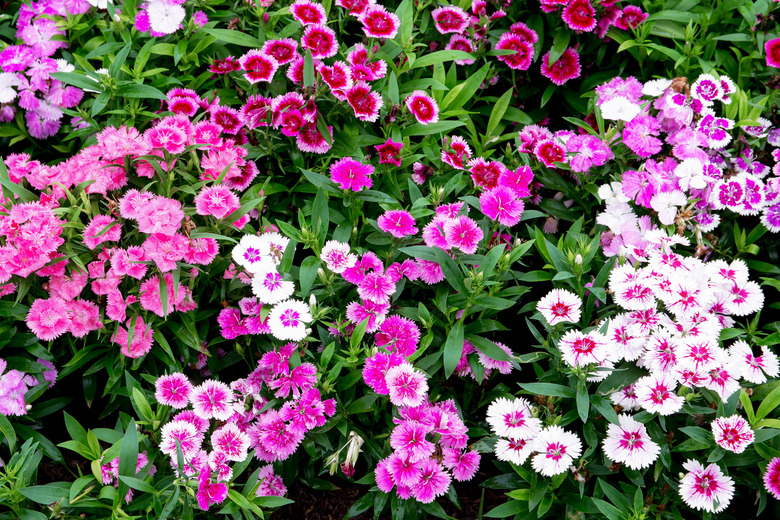How To Prune Dianthus For Regrowth
We may receive a commission on purchases made from links.
Dianthus (Dianthus spp.) is a group of annuals, biennials, and short-lived perennials in the carnation or pink family (Caryophyllaceae) that thrive in U.S. Department of Agriculture plant hardiness zones 3 through 10 depending on the species. Fragrant and long-blooming, there are more than 27,000 registered dianthus varieties among the approximately 340 species. Like other flower species, deadheading and pruning encourage extended blooming and regrowth.
Common Dianthus Varieties
Common Dianthus Varieties
Among the well-known dianthus varieties grown in cottage and informal gardens are carnations (Dianthus caryophyllus), China pinks (Dianthus chinensis), cottage pinks (Dianthus plumarius) and sweet Williams (Dianthus barbatus). Carnations grow up to 36 inches tall in USDA zones 5 through 9 depending on the cultivar. More suited to small gardens and borders, China pinks grow into 3- to 4-inch-tall mounds with flowers rising above the foliage on 6- to 10-inch stems. They are often grown as annuals, though they are hardy in USDA zones 7 through 10.
The sweet William cultivars grow into 12- to 24-inch-tall mounds and produce clusters of white, pink, salmon, red, or bicolor flowers, while cottage pinks produce their pale pink blossoms amid the mounds of 12- to 15-inch-tall leaves. Both species thrive in USDA zones 3 through 9.
Generally, dianthus plants produce clumping mounds of narrow green, blue-green, or silver-green leaves with flowers rising above the foliage. Nearly all dianthus flowers have a spicy fragrance, and their petals can be used for cordials, syrups, and vinegars.
Planting Dianthus in the Garden
Planting Dianthus in the Garden
Prepare a sunny, well-drained garden bed in spring by digging in 2 to 4 inches of compost. Scatter seeds, cover with 1/8 inch of moist soil, and tamp gently. If seeds are started indoors in peat pots eight weeks before the last frost date or planted outside in early spring, biennial and perennial species may bloom late in the season, but generally, they will begin flowering the following year. The seeds germinate in two to three weeks; keep the soil or potting mix lightly moist until the seedlings appear.
You can also divide existing plants in early spring before new growth begins. Dividing clumps that are not producing as many flowers is one way to rejuvenate the plants. Replant in freshly amended, well-drained locations or flowerpots at the same depth as they were previously. Space transplants according to their mature size, from 6 to 24 inches apart.
Caring for Dianthus
Caring for Dianthus
Water when the soil is dry to a depth of 1 inch using a soaker hose or hose end bubbler to avoid wetting the foliage. Add a layer of gravel mulch around the plants to keep the leaves off the soil and help prevent crown rot. When new growth appears in spring, add a shovelful of compost over the mulch or scatter a slow-release fertilizer formulated for flowers around the plants, avoiding the crown. Water thoroughly after fertilizing.
Potted dianthus should be watered more frequently in hot weather and fertilized biweekly with a half-strength liquid fertilizer. In mid to late summer, dianthus may require some afternoon shade to protect the plants from the hot sun. Move potted plants into dappled shade or add light shade with an old bed sheet or shade cloth supported by stakes.
Deadheading and Pruning
Deadheading and Pruning
Put on long sleeves, safety goggles, and gloves to protect your skin and eyes. Dianthus may cause a rash in sensitive individuals. Keep the plants and trimmings out of the reach of children and pets, as the leaves may cause gastric distress if eaten. Before you begin to prune or deadhead, sterilize your cutting tools by soaking the blades in one of the following for at least five minutes to help prevent the spread of diseases from one plant to the next: full-strength Lysol, a solution of equal parts water and 70 percent rubbing alcohol, or a solution of 1 part Pine-Sol and 3 parts water. Allow your tools to air-dry or rinse them in clean water prior to use.
Deadhead fading flowers before they begin to set seed. This encourages the plant to produce more flower buds. Wait until the weather cools before allowing the last flowers of the season to set seed. You can leave the seeds for natural reseeding in the garden or harvest them to plant in spring.
If your dianthus begins to look scraggly with thin, too-tall stems, shear the plants by up to one-third to encourage dense new foliage. Lightly fertilize with a liquid 20-10-20 fertilizer to support the new growth.
References
- Burpee: Learn About Dianthus
- Almanac: Dianthus Flowers: A Rock Garden Favorite
- North Carolina Extension Gardener Plant Toolbox: Dianthus
- North Carolina Extension Gardener Plant Toolbox: Dianthus plumarius
- Missouri Botanical Garden: Dianthus barbatus
- University of Florida IFAS Extension: Disinfecting Pruning Tools
